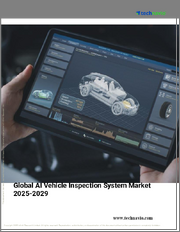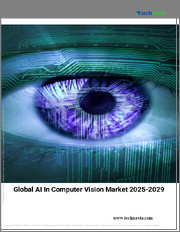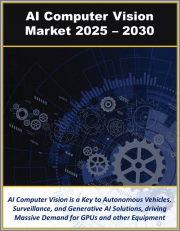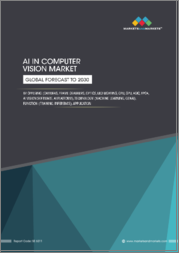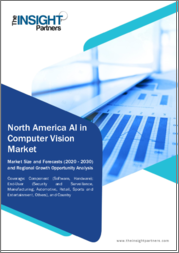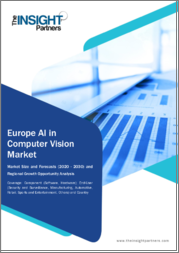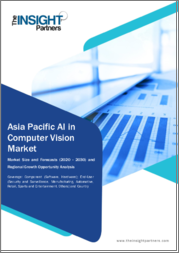
|
시장보고서
상품코드
1533165
아시아태평양의 컴퓨터 비전용 AI 시장 예측(-2030년) 분석 : 지역별, 컴포넌트별, 최종 용도 산업별Asia Pacific AI in Computer Vision Market Forecast to 2030 - Regional Analysis - by Component (Software and Hardware) and End Use Industry (Security and Surveillance, Manufacturing, Automotive, Retail, Sports and Entertainment, and Others) |
||||||
아시아태평양의 컴퓨터 비전용 AI(AI in Computer Vision) 시장은 2022년에 32억 2,583만 달러로 평가되었고, 2030년에는 357억 7,841만 달러에 이를 것으로 예측되며, 2022-2030년간 CAGR은 35.1%를 기록 그렇다고 예측됩니다.
자율주행차 제조 증가가 아시아태평양의 컴퓨터 비전 AI 시장을 뒷받침
컴퓨터 비전은 자율주행차와 자율주행차를 개발하기 위한 기본 기술입니다. 필요한 지각 능력을 제공함으로써 인간의 개입 없이 차량을 안전하게 탐색하고 운전할 수 있습니다. 컴퓨터 비전 알고리즘은 교통 표지, 차선 표시, 신호, 도로 상황 등 복잡한 시각 데이터를 해석할 수 있습니다. 이를 통해 자율주행차는 자신의 움직임에 대한 정보를 바탕으로 판단을 내리고 그에 따라 행동을 조정할 수 있습니다. 컴퓨터 비전은 자율 주행 차량 기술의 중심에 있습니다. 최신 카메라나 센서를 사용하면서 물체 검출 알고리즘을 활용함으로써 자율주행차는 주위의 상황을 파악할 수 있게 되어, 운전 프로세스 전체가 보다 안전하게 됩니다. 컴퓨터 비전의 모델을 통해 자율 주행 차량은 보행자와 자전거에 부딪히기 전에 멈출 수 있습니다. 다양한 기업들이 새로운 자율주행차를 발표하고 있습니다. 예를 들어, Minus Zero는 2023년 6월, 인도 최초의 자율주행차와 함께 수수께끼의 zPod을 발표했습니다. zPod은 인공지능(AI) 기업이 개발한 자율주행 기술을 선보였습니다. Minus Zero는 자사의 자율 주행 기술을 다른 제조업체에 제공하고 ADAS 제품군을 개선하는 데 도움이 될 것이라고 말했습니다. 따라서 자율주행차의 제조가 증가함에 따라 컴퓨터 비전용 AI 시장에 성장 기회가 생길 것으로 예상됩니다.
아시아태평양(APAC)의 컴퓨터 비전용 AI 시장 개요
아시아는 세계 디지털 혁명의 최전선에 있습니다. 아시아 기업은 공장의 노동력, 자동화, 심지어 조직의 정보기술 네트워크라는 점에서 기본적으로 백지 상태에서 견고한 디지털 사업을 시작할 수 있다는 장점으로 구미 기업을 훨씬 능가합니다. APAC의 다양한 기업들이 새로운 자동화 센터를 시작하고 있습니다. 예를 들어 공장 오토메이션 업계에서 사업을 전개하는 오므론은 2022년 12월 동남아시아, 싱가포르, 오세아니아의 물류 부문에 최초의 오토메이션 센터를 시작하여 서비스를 제공한다고 발표했습니다. 회사 오므론은 Industry 4.0 솔루션을 제공하는 자동화 센터를 확장했습니다. 이 회사의 자동화 센터는 물류 업계에서 로봇 미들웨어 프레임워크(RMF)의 도입을 지원하는 솔루션 개발 센터 중 하나입니다. Omron Automation Center Singapore for Logistics로 알려져 있습니다.
또한 다양한 기업들이 APAC에서 새로운 자율주행차를 출시하고 있습니다. 예를 들어, 바이두는 2022년 7월 차세대 완전 자율주행차(AV)인 Apollo RT6을 발표했습니다. 이것은 복잡한 도시 환경을 위해 설계된 것으로, Apollo RT6는 2023년 중국에서 자율 주행형 라이드 셰어링'Apollo Go'에서 운행이 시작되었습니다. 마찬가지로 2021년 5월 SK Holdings는 Kodiak Robotics와 제휴하여 아시아태평양 자율주행으로 1조 2,900억 달러를 목표로 합니다. Kodiak Robotics는 SK Corporation에 첨단 긴급 브레이크 시스템 및 인공지능(AI) 마이크로프로세서와 같은 자율 주행 시스템을 제공했습니다. 컴퓨터 비전 기술은 자율 주행 차량에 널리 사용되고 있기 때문에 이러한 사례가 증가함에 따라 컴퓨터 비전용 AI 시장은 아시아태평양에서 성장하고 있습니다.
아시아태평양의 컴퓨터 비전용 AI 시장 매출 및 예측(-2030년, 금액 기준)
아시아태평양의 컴퓨터 비전용 AI 시장 세분화
아시아태평양의 컴퓨터 비전용 AI 시장은 컴포넌트, 최종 용도 산업, 국가에 따라 세분화됩니다. 컴포넌트에 따라 아시아태평양의 컴퓨터 비전용 AI 시장은 소프트웨어와 하드웨어로 나뉩니다. 2022년 시장 점유율은 소프트웨어 분야가 큽니다.
최종 용도 산업에서 아시아태평양의 컴퓨터 비전용 AI 시장은 보안 및 감시, 제조, 자동차, 소매, 스포츠 및 엔터테인먼트 등으로 분류됩니다. 보안·감시 분야가 2022년 최대 시장 점유율을 차지합니다.
국가별로 아시아태평양의 컴퓨터 비전 AI 시장은 중국, 일본, 인도, 호주, 한국 및 기타 아시아태평양으로 구분됩니다. 2022년 아시아태평양의 컴퓨터 비전 AI 시장 점유율은 중국이 독점했습니다.
Advanced Micro Devices Inc, Cognex Corp, General Electric Co, Intel Corp, Microsoft Corp, Qualcomm Inc, Teledyne Technologies Inc, NVIDIA Corp, BASLER AG, International Business Machines Corp는 아시아태평양 컴퓨터 비전 AI 시장에서 사업을 전개하는 선두 기업입니다.
목차
제1장 서론
제2장 주요 요약
- 주요 인사이트
- 시장의 매력
제3장 조사 방법
- 조사 범위
- 2차 조사
- 1차 조사
제4장 아시아태평양의 컴퓨터 비전용 AI 시장 상황
- 생태계 분석
- 하드웨어 컴포넌트 제공업체
- 소프트웨어 개발자
- 시스템 통합자
- 최종 용도 산업
- 밸류체인의 벤더 목록
제5장 아시아태평양의 컴퓨터 비전용 AI 시장 : 주요 산업 역학
- 컴퓨터 비전용 AI 시장-주요 산업 역학
- 시장 성장 촉진요인
- 인더스트리 4.0의 채택 확대
- 헬스케어, 농업, 소매 업계에서 용도 증가
- 시장 성장 억제요인
- AI 기반의 컴퓨터 비전 솔루션의 막대한 조달 비용과 구현의 복잡성
- 프라이버시에 관한 우려의 증대
- 시장 기회
- 자율주행차의 제조 증가
- AI 관련 기술 개발을 뒷받침하는 정부 이니셔티브의 대두
- 향후 동향
- 엣지 컴퓨터 비전
- 실시간 비디오 분석
- 성장 촉진 및 억제요인 영향
제6장 컴퓨터 비전용 AI 시장 : 아시아태평양 시장 분석
- 컴퓨터 비전용 AI 시장 매출(2020-2030년)
- 컴퓨터 비전용 AI 시장 예측 및 분석
제7장 컴퓨터 비전용 AI 시장 : 아시아태평양
- 소프트웨어
- 소프트웨어 : 시장 매출 및 예측(-2030년)
- 하드웨어
- 하드웨어 : 시장 매출 및 예측(-2030년)
제8장 아시아태평양의 컴퓨터 비전 AI 시장 분석 : 최종 용도 산업별
- 보안 및 감시
- 보안 및 감시 : 시장 매출 및 예측(-2030년)
- 제조업
- 제조업 : 시장 매출 및 예측(-2030년)
- 자동차
- 자동차 : 시장 매출 및 예측(-2030년)
- 소매
- 소매 : 시장 매출 및 예측(-2030년)
- 스포츠 및 엔터테인먼트
- 스포츠 및 엔터테인먼트 : 시장 매출 및 예측(-2030년)
- 기타
- 기타 : 시장 매출 및 예측(-2030년)
제9장 아시아태평양의 컴퓨터 비전용 AI 시장 : 국가별 분석
- 아시아태평양
- 중국
- 일본
- 한국
- 인도
- 호주
- 기타 아시아태평양
제10장 경쟁 구도
- 기업의 포지셔닝과 집중도
제11장 업계 정세
- 시장에 대한 대처
- 신제품 개발
- 합병 및 인수
제12장 기업 프로파일
- Advanced Micro Devices Inc
- Cognex Corp
- General Electric Co
- Intel Corp
- Microsoft Corp
- Qualcomm Inc
- Teledyne Technologies Inc
- NVIDIA Corp
- BASLER AG
- International Business Machines Corp
제13장 부록
LYJThe Asia Pacific AI in computer vision market was valued at US$ 3,225.83 million in 2022 and is expected to reach US$ 35,778.41 million by 2030; it is estimated to record a CAGR of 35.1% from 2022 to 2030.
Increased Manufacturing of Autonomous Vehicles Boosts Asia Pacific AI in Computer Vision Market
Computer vision is a fundamental technology for developing autonomous or self-driving vehicles. It provides the necessary perception capabilities, enabling vehicles to navigate and operate safely without human intervention. Computer vision algorithms can interpret complex visual data, including traffic signs, lane markings, traffic lights, and road conditions. This allows autonomous vehicles to make informed decisions about their movements and adjust their behavior accordingly. Computer vision is at the center of autonomous vehicle technology. By leveraging object detection algorithms while also using the latest cameras and sensors, autonomous vehicles get to identify their surroundings, making the entire driving process safer. Computer vision models allow autonomous vehicles to stop before they hit walkers or cyclists. Various companies are launching new autonomous vehicles. For instance, in June 2023, Minus Zero unveiled the zPod, which it claimed to be India's first autonomous vehicle. The zPod showcased self-driving tech developed by the artificial intelligence (AI) firm. Minus Zero said that it would provide its autonomous driving tech to other manufacturers to help improve their ADAS suite. Therefore, the increasing manufacturing of autonomous vehicles is anticipated to provide growth opportunities for the AI in computer vision market.
Asia Pacific AI in Computer Vision Market Overview
Asia is at the forefront of the global digital revolution. Asian companies are far out-maneuvering their Western counterparts due to the advantage of setting up robust digital operations from basically a blank slate in terms of factory workforce, automation, and even organization information technology networks. Various companies in APAC are launching new automation centers. For instance, in December 2022, OMRON, a company operating in the factory automation industry, announced that it would be serving the logistics sector in Southeast Asia, Singapore, and Oceania with its first automation center, which was launched in 2022. The company Omron expanded its automation center, which offers Industry 4.0 solutions. It's automation center is one of the solution development centers that supports the implementation of the Robotics Middleware Framework (RMF) in the logistics industry. It is known as Omron Automation Center Singapore for Logistics.
Furthermore, various companies are launching new autonomous vehicles in APAC. For example, in July 2022, Baidu, Inc. announced its next-generation completely autonomous vehicle (AV), Apollo RT6, a production-ready model with a removable steering wheel. It was designed for complex urban environments; Apollo RT6 was put into operation in China in 2023 on Apollo Go autonomous ride-hailing service. Similarly, in May 2021, SK Holdings partnered with Kodiak Robotics, to target US$ 1290 billion in Asia Pacific autonomous driving. Kodiak Robotics provided SK Corporation with autonomous driving systems, such as advanced emergency braking systems and artificial intelligence (AI) microprocessors. The computer vision technology is used widely in autonomous vehicles Therefore, with such increasing instances, the AI in computer vision market is growing in Asia Pacific.
Asia Pacific AI in Computer Vision Market Revenue and Forecast to 2030 (US$ Million)
Asia Pacific AI in Computer Vision Market Segmentation
The Asia Pacific AI in computer vision market is segmented based on component, end use industry, and country. Based on component, the Asia Pacific AI in computer vision market is bifurcated into software and hardware. The software segment held a larger market share in 2022.
In terms of end use industry, the Asia Pacific AI in computer vision market is categorized into security and surveillance, manufacturing, automotive, retail, sports and entertainment, and others. The security and surveillance segment held the largest market share in 2022.
Based on country, the Asia Pacific AI in computer vision market is segmented into China, Japan, India, Australia, South Korea, and the Rest of Asia Pacific. China dominated the Asia Pacific AI in computer vision market share in 2022.
Advanced Micro Devices Inc, Cognex Corp, General Electric Co, Intel Corp, Microsoft Corp, Qualcomm Inc, Teledyne Technologies Inc, NVIDIA Corp, BASLER AG, and International Business Machines Corp are some of the leading players operating in the Asia Pacific AI in computer vision market.
Table Of Contents
1. Introduction
- 1.1 The Insight Partners Research Report Guidance
- 1.2 Market Segmentation
2. Executive Summary
- 2.1 Key Insights
- 2.2 Market Attractiveness
3. Research Methodology
- 3.1 Coverage
- 3.2 Secondary Research
- 3.3 Primary Research
4. Asia Pacific AI in Computer Vision Market Landscape
- 4.1 Overview
- 4.2 Ecosystem Analysis
- 4.2.1 Hardware Component Providers:
- 4.2.2 Software Developers:
- 4.2.3 System Integrator:
- 4.2.4 End Use Industry:
- 4.2.5 List of Vendors in Value Chain
5. Asia Pacific AI in Computer Vision Market - Key Industry Dynamics
- 5.1 AI in Computer Vision Market - Key Industry Dynamics
- 5.2 Market Drivers
- 5.2.1 Growing Adoption of Industry 4.0
- 5.2.2 Rising Applications in Healthcare, Agriculture, and Retail Industries
- 5.3 Market Restraints
- 5.3.1 High Cost of Procuring and Complexity of Implementing AI-Based Computer Vision Solutions
- 5.3.2 Increase In Privacy Concerns
- 5.4 Market Opportunities
- 5.4.1 Increased Manufacturing of Autonomous Vehicles
- 5.4.2 Rise in Government Initiatives to Boost Development of AI-Related Technologies
- 5.5 Future Trends
- 5.5.1 Edge Computer Vision
- 5.5.2 Real- Time Video Analytics
- 5.6 Impact of Drivers and Restraints:
6. AI in Computer Vision Market - Asia Pacific Market Analysis
- 6.1 AI in Computer Vision Market Revenue (US$ Million), 2020 - 2030
- 6.2 AI in Computer Vision Market Forecast and Analysis
7. Asia Pacific AI in Computer Vision Market Analysis - Component
- 7.1 Software
- 7.1.1 Overview
- 7.1.2 Software: Market Revenue and Forecast to 2030 (US$ Million)
- 7.2 Hardware
- 7.2.1 Overview
- 7.2.2 Hardware: Market Revenue and Forecast to 2030 (US$ Million)
8. Asia Pacific AI in Computer Vision Market Analysis - End Use Industry
- 8.1 Security and Surveillance
- 8.1.1 Overview
- 8.1.2 Security and Surveillance: Market Revenue and Forecast to 2030 (US$ Million)
- 8.2 Manufacturing
- 8.2.1 Overview
- 8.2.2 Manufacturing: Market Revenue and Forecast to 2030 (US$ Million)
- 8.3 Automotive
- 8.3.1 Overview
- 8.3.2 Automotive: Market Revenue and Forecast to 2030 (US$ Million)
- 8.4 Retail
- 8.4.1 Overview
- 8.4.2 Retail: Market Revenue and Forecast to 2030 (US$ Million)
- 8.5 Sports and Entertainment
- 8.5.1 Overview
- 8.5.2 Sports and Entertainment: Market Revenue and Forecast to 2030 (US$ Million)
- 8.6 Others
- 8.6.1 Overview
- 8.6.2 Others: Market Revenue and Forecast to 2030 (US$ Million)
9. Asia Pacific AI in Computer Vision Market - Country Analysis
- 9.1 Asia Pacific
- 9.1.1 Asia Pacific AI in Computer Vision Market Overview
- 9.1.2 Asia Pacific AI in Computer Vision Market Revenue and Forecasts and Analysis - By Country
- 9.1.2.1 Asia Pacific AI in Computer Vision Market Revenue and Forecasts and Analysis - By Country
- 9.1.2.2 China AI in Computer Vision Market Revenue and Forecasts to 2030 (US$ Mn)
- 9.1.2.2.1 China AI in Computer Vision Market Breakdown by Component
- 9.1.2.2.2 China AI in Computer Vision Market Breakdown by End Use Industry
- 9.1.2.3 Japan AI in Computer Vision Market Revenue and Forecasts to 2030 (US$ Mn)
- 9.1.2.3.1 Japan AI in Computer Vision Market Breakdown by Component
- 9.1.2.3.2 Japan AI in Computer Vision Market Breakdown by End Use Industry
- 9.1.2.4 South Korea AI in Computer Vision Market Revenue and Forecasts to 2030 (US$ Mn)
- 9.1.2.4.1 South Korea AI in Computer Vision Market Breakdown by Component
- 9.1.2.4.2 South Korea AI in Computer Vision Market Breakdown by End Use Industry
- 9.1.2.5 India AI in Computer Vision Market Revenue and Forecasts to 2030 (US$ Mn)
- 9.1.2.5.1 India AI in Computer Vision Market Breakdown by Component
- 9.1.2.5.2 India AI in Computer Vision Market Breakdown by End Use Industry
- 9.1.2.6 Australia AI in Computer Vision Market Revenue and Forecasts to 2030 (US$ Mn)
- 9.1.2.6.1 Australia AI in Computer Vision Market Breakdown by Component
- 9.1.2.6.2 Australia AI in Computer Vision Market Breakdown by End Use Industry
- 9.1.2.7 Rest of Asia Pacific AI in Computer Vision Market Revenue and Forecasts to 2030 (US$ Mn)
- 9.1.2.7.1 Rest of Asia Pacific AI in Computer Vision Market Breakdown by Component
- 9.1.2.7.2 Rest of Asia Pacific AI in Computer Vision Market Breakdown by End Use Industry
10. Competitive Landscape
- 10.1 Company Positioning & Concentration
11. Industry Landscape
- 11.1 Overview
- 11.2 Market Initiative
- 11.3 New Product Development
- 11.4 Merger and Acquisition
12. Company Profiles
- 12.1 Advanced Micro Devices Inc
- 12.1.1 Key Facts
- 12.1.2 Business Description
- 12.1.3 Products and Services
- 12.1.4 Financial Overview
- 12.1.5 SWOT Analysis
- 12.1.6 Key Developments
- 12.2 Cognex Corp
- 12.2.1 Key Facts
- 12.2.2 Business Description
- 12.2.3 Products and Services
- 12.2.4 Financial Overview
- 12.2.5 SWOT Analysis
- 12.2.6 Key Developments
- 12.3 General Electric Co
- 12.3.1 Key Facts
- 12.3.2 Business Description
- 12.3.3 Products and Services
- 12.3.4 Financial Overview
- 12.3.5 SWOT Analysis
- 12.3.6 Key Developments
- 12.4 Intel Corp
- 12.4.1 Key Facts
- 12.4.2 Business Description
- 12.4.3 Products and Services
- 12.4.4 Financial Overview
- 12.4.5 SWOT Analysis
- 12.4.6 Key Developments
- 12.5 Microsoft Corp
- 12.5.1 Key Facts
- 12.5.2 Business Description
- 12.5.3 Products and Services
- 12.5.4 Financial Overview
- 12.5.5 SWOT Analysis
- 12.5.6 Key Developments
- 12.6 Qualcomm Inc
- 12.6.1 Key Facts
- 12.6.2 Business Description
- 12.6.3 Products and Services
- 12.6.4 Financial Overview
- 12.6.5 SWOT Analysis
- 12.6.6 Key Developments
- 12.7 Teledyne Technologies Inc
- 12.7.1 Key Facts
- 12.7.2 Business Description
- 12.7.3 Products and Services
- 12.7.4 Financial Overview
- 12.7.5 SWOT Analysis
- 12.7.6 Key Developments
- 12.8 NVIDIA Corp
- 12.8.1 Key Facts
- 12.8.2 Business Description
- 12.8.3 Products and Services
- 12.8.4 Financial Overview
- 12.8.5 SWOT Analysis
- 12.8.6 Key Developments
- 12.9 BASLER AG
- 12.9.1 Key Facts
- 12.9.2 Business Description
- 12.9.3 Products and Services
- 12.9.4 Financial Overview
- 12.9.5 SWOT Analysis
- 12.9.6 Key Developments
- 12.10 International Business Machines Corp
- 12.10.1 Key Facts
- 12.10.2 Business Description
- 12.10.3 Products and Services
- 12.10.4 Financial Overview
- 12.10.5 SWOT Analysis
- 12.10.6 Key Developments
13. Appendix
- 13.1 About The Insight Partners
- 13.2 Word Index






